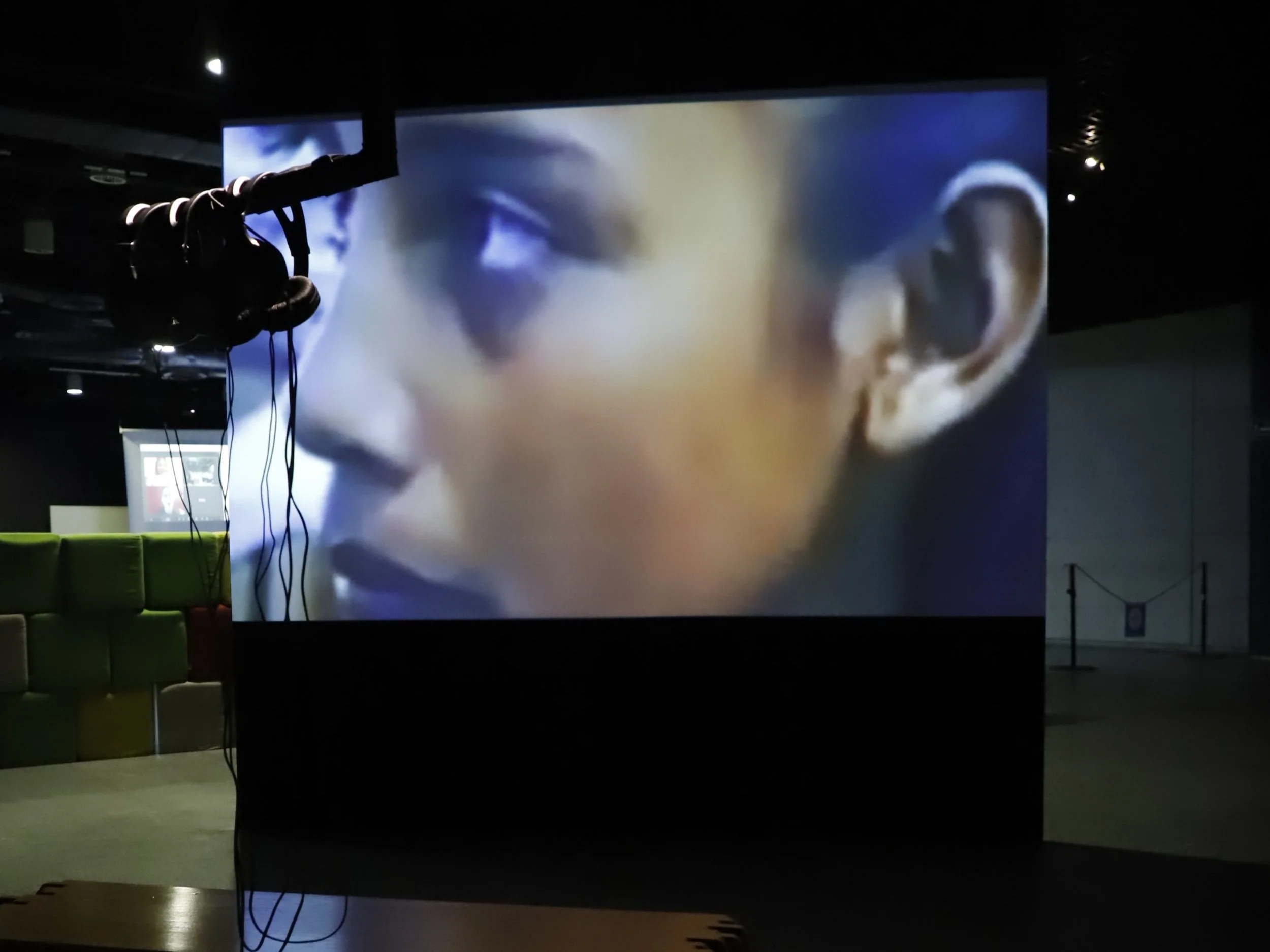A face that is multiple faces, a voice that is multiple voices
by Doreen Ríos
Exhibition view, Desde la ceguera, 2023. Centro de Cultura Digital. Photography by Coral Castillo Mar.
How come machines see us but they can’t find us? Various technological devices constantly monitor, measure, and track us, yet their inability to locate us if we go missing raises plenty of questions on their implementation and use. Each time I encounter a missing person flyer, typically looking for a female-identifying person or a minority, I'm confronted with the grim reality in Mexico: the likelihood of finding these individuals alive is small. In this scenario, I wonder how is it that the Mexican government became the first client of the Pegasus spyware in 2011, which, according to The New York Times [1] “(...) inaugurated its spread around the globe.” and yet this same government is the one unable to find us? Wasn't the primary aim of surveillance technologies to prevent violence? Weren’t we trading our privacy rights for collective security? Wasn't technopositivism [2] meant to promise a brighter future for us all? Or does this discourse cater only to those who benefit from this information asymmetry? This contradiction is not only suspicious but it also opens up discussions about the dynamics between technology, surveillance, gender violence, and those in positions of power.
Taking place at Centro de Cultura Digital in Mexico City, the exhibition Desde la Ceguera developed by Ghost Agency [3], proposes a critical reflection of this conflicting ecosystem through three key artworks — Storification, Cecilia, and Ghost Agencies Prologue. These pieces are provocations about privacy, trust, agency, and a trigger to reevaluate our relationship with technology on various levels. Geert Lovink and David García’s [4] exploration of the concept of tactical media as platforms of crisis, criticism, and opposition in 1997 remains pertinent. Despite the proliferation of technological devices since then, the capacity to dissect and critically evaluate its contents has become increasingly limited. In this vaporous landscape, the work of Ghost Agency assumes a central role in redefining the potential of tactical media.
Ghost Agency, Storification, 2023. Photography by Daniela Torib.
We can clearly see how the artists tap on these reconsiderations in Storification (2023). This video explores Mexico's political landscape amidst normalized exploitation, notably affecting women. It focuses on the role of gore capitalism [5] — as seen through maquiladoras [6], drug cartel violence, and immigration necropolicies [7] just to name a few — on the northern border and its direct correlation with exploitative conditions, underpayment, and precarious labor practices. Edited in real-time, the video's ever-evolving sequences are complemented by the voice of poet and artist Mónica Nepote, entwined with a sound composition made up of a selection of tracks from various contemporary Mexican composers mixed by Nadia López Andrade. This artwork shows bodies and faces that represent a multitude yet embody no singular identity created through AI while posing questions around women's rights in the digital age. Storification aims to reveal the capitalist urge for flattening all identities while demanding work, consumption, and attention through biased machines.
Ghost Agency, Ghost Agencies Prologue, 2023. Photography by Anni Garza Lau.
Similarly, the artwork Ghost Agencies Prologue (2023) also uses video as a medium to reflect upon the intersection of AI, gender violence, and impunity. Through the use of machine learning to generate elusive, obfuscated faces, the artists build a connection between the noise of information and the unsettling phenomena of disappearances prevalent in today's media landscape. This visual narrative portrays the constant violence women encounter across various spheres, spanning from public to private domains. It questions the paradoxical role of various technologies, marketed as solutions to combat violence, yet seemingly indifferent or unresponsive when it comes to the prosecution of these acts.
Ghost Agency, Cecilia, 2023. Photography by Daniela Torib.
On a slightly different note, Cecilia (2023) embodies an activist persona through an AI chatbot with which the audience can interact. Living inside a delicate fortress surrounded by black cotton blinds, Cecilia uses various means for making herself present while sharing her quest for justice and societal transformation within Mexico's patriarchal framework. Her interactions offer glimpses of her story, one filled with violence, that, unfortunately, will inevitably resonate with the story of others. She is a humanized chatbot that reveals other possibilities for AI implementation while encapsulating other people’s stories within her training.
In order to expand on these artworks, it is useful to revisit the Pegasus malware, developed by the Israeli company NSO Group, as a case study on the weaponization of surveillance technologies against civilians. Originally intended for specific law enforcement purposes, sooner than later Pegasus turned into a tool of omnipresent surveillance, targeting not just criminal entities but dissenting voices across the sociopolitical spectrum. Activists, journalists, and political dissidents found themselves trapped within its ubiquitous gaze.
This is one of many reasons why it becomes essential to collectively envision alternative approaches and highlight the role of operating within the realm of tactical media. Ghost Agency’s research and art production focuses on appropriating diverse mediums, knowledge forms, visual languages, and technological devices. Their approach inherently challenges established hierarchies and dismantles false dichotomies. Presenting an incredibly necessary critical conversation in collaboration with various institutions, collectives, and individuals that aims to find another path forward in regards to women’s rights in the age of surveillance, necropolitics, and gore capitalism.
[1] Kitroeff, & Bergman. (2023, April 18). How Mexico Became the Biggest User of the World’s Most Notorious Spy Tool. The New York Times. Retrieved November 21, 2023, from https://www.nytimes.com/2023/04/18/world/americas/pegasus-spyware-mexico.html
[2] The belief that technology is, inherently, good.
[3] Duo conformed by Gro Sarauw and Anni Garza Lau.
[4] García, David, and Lovink, Geert, The ABC Tactical Media, nettime international mailing list for net criticism, 1997. Retrieved November 21, 2023, from www.nettime.org/Lists-Archives/nettime-l-9705/msg00096.html
[5] A term coined by Sayak Valencia, critical theorist and activist from Tijuana, it refers to contemporary violence as a commodity of late capitalism.
[6] The term maquiladora refers to a factory or manufacturing plant in Mexico. These corporations are approved for operation by the country's Secretariat of Commerce and Industrial Development under a decree established in 1989 and are owned by foreign entities. (Kenton, 2022)
[7] As seen through the lens of Achille Mbembe, necropolitics refers to “the capacity to define who matters and who does not, who is disposable and who is not.” (Mbembe, 2003)



